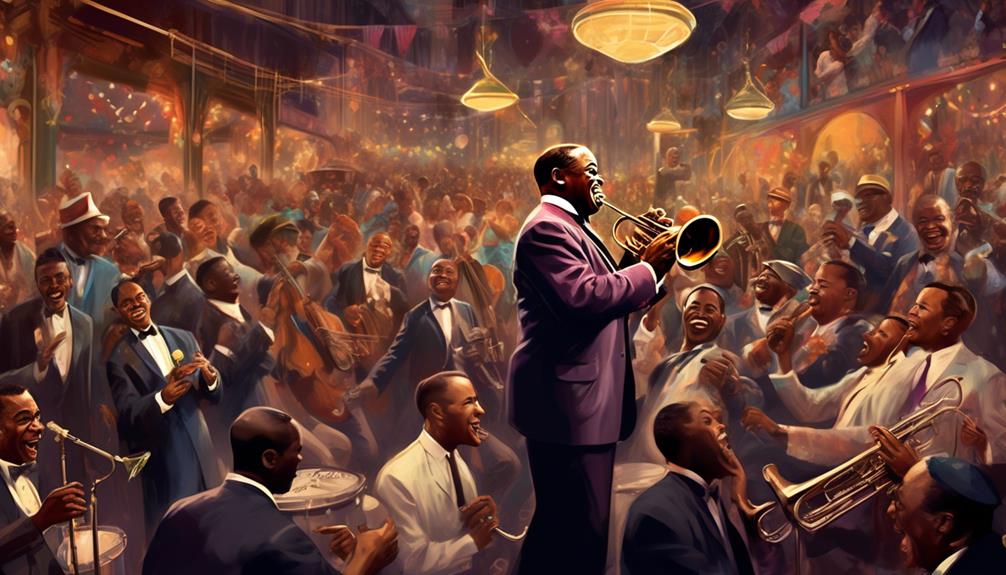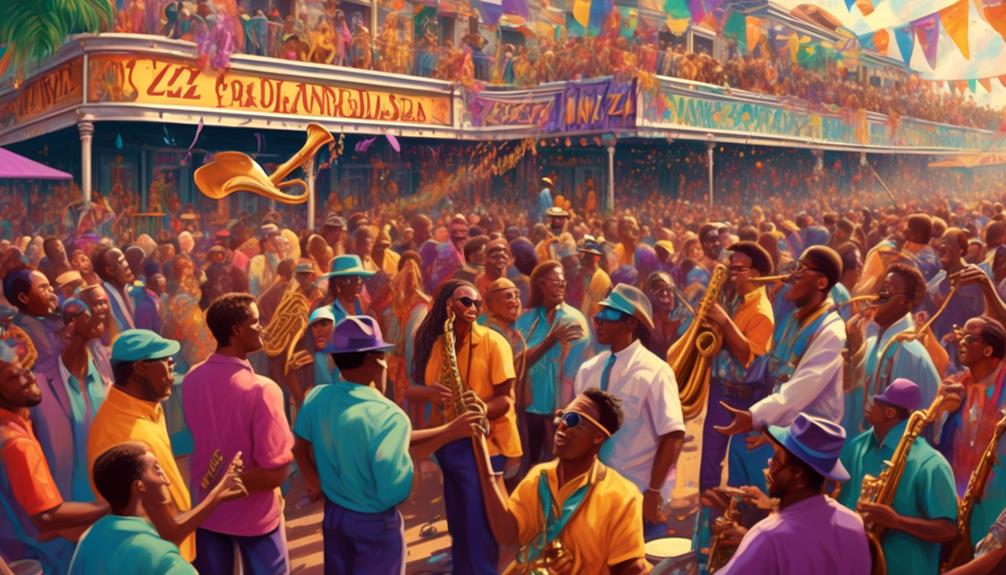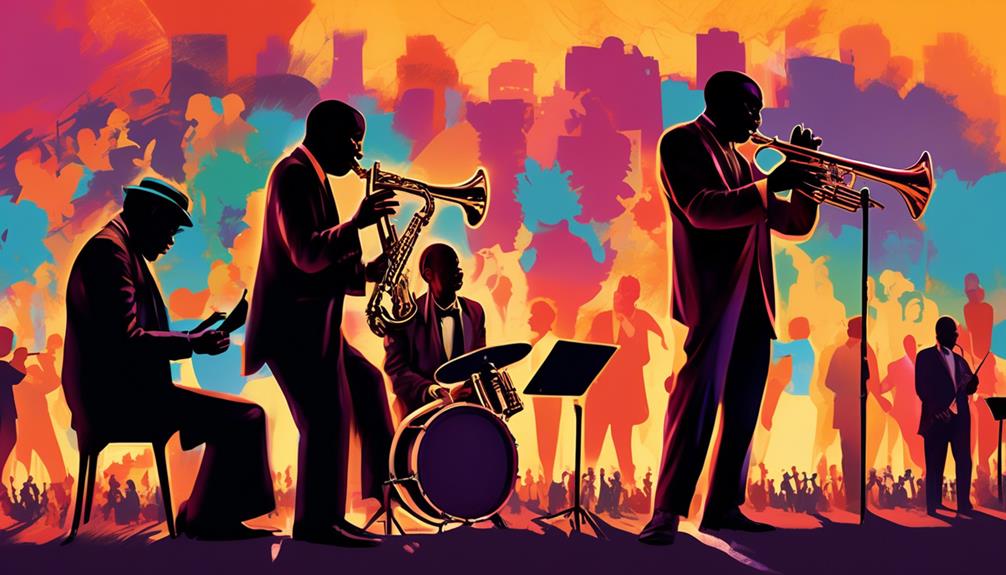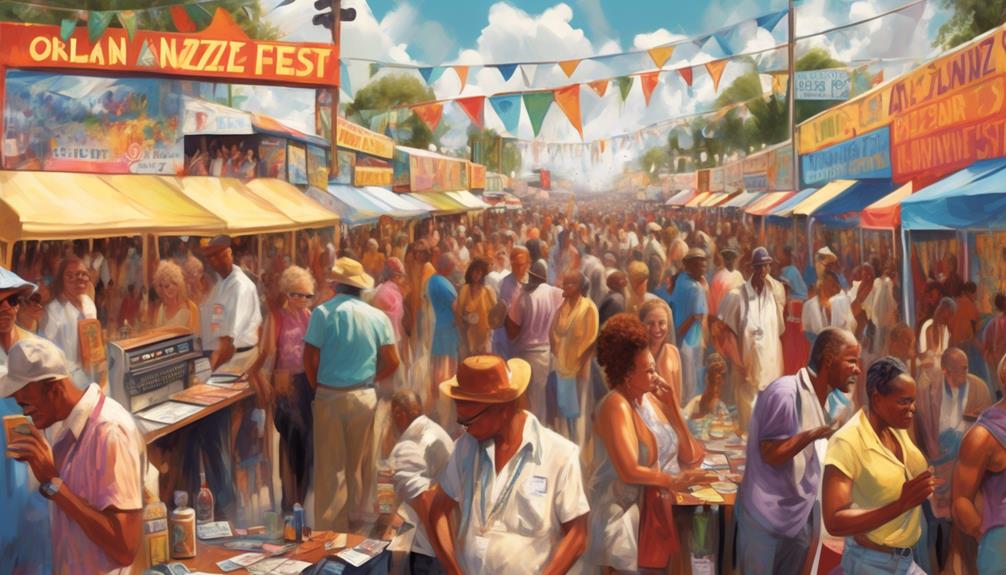
Imagine standing at the crossroads of history, where every note played is a seismic event reverberating through the annals of jazz. You're about to embark on a journey through the rich tapestry of the Orleans Jazz Fest, a cultural mélange that's as vibrant and diverse as the city it calls home.
We'll chart its humble beginnings in 1970, its momentous relocation in 1972, and the unprecedented silence in 2020, a year that left its stages eerily quiet. But don't mistake this for a simple chronology; it's a testament to the indomitable spirit of a city and its music.
So, shall we proceed?
Key Takeaways
- The Orleans Jazz Fest was established in 1970 to celebrate and preserve Louisiana's music, culture, and heritage.
- The festival faced financial struggles and controversies but experienced a significant increase in attendance in 1990.
- The introduction of corporate sponsorships helped ensure financial stability and expansion, transforming the festival into an international attraction with big-name headliners.
- Jazz Fest has had a significant economic influence on New Orleans, attracting thousands of visitors each year and contributing to the city's cultural economy.
The Inception of Orleans Jazz Fest
Established in 1970 by George Wein, Quint Davis, and Allison Miner, the Orleans Jazz Fest initially aimed to celebrate and preserve Louisiana's rich music, culture, and heritage. The inaugural New Orleans Jazz Fest, a vibrant showcase of local music styles, delicious Louisiana cuisine, and diverse arts and crafts, took place at the iconic Congo Square. This was the first time that such a significant event had been organized to highlight and uphold the cultural value of Louisiana's heritage.
In 1972, the fest relocated to the Orleans Fair Grounds Race Course, marking the beginning of an era of growth and expansion. The New Orleans Jazz Fests became a multi-weekend affair, contributing significantly to the city's tourism boom. But it wasn't always smooth sailing. The History of the New Orleans Jazz and Heritage Festival and Foundation has seen its fair share of financial struggles and controversies.
Local activists have leveled accusations of performer exploitation and community underrepresentation, challenging the New Orleans International Jazz Fest to continuously strive for inclusivity and fairness. Despite these challenges, the New Orleans Jazz Fest continues to be a crucial part of Louisiana's cultural tapestry.
1970: First Festival's Highlights
Now, let's take a closer look at the highlights from the first Orleans Jazz Fest that set the tone for the event's illustrious future.
The first Jazz and Heritage Festival was presented in 1970 at the Fair Grounds Race Course, an iconic landmark that hosts the festival on the Fair Grounds each year. The Jazz Fest took place under the masterful guidance of producer Quint Davis, with a lineup that included New Orleans musicians like Al Hirt and Fats Domino.
The first festival's highlights were many, but Pete Fountain's steamship concert and Duke Ellington's closing performance were truly unforgettable.
Mahalia Jackson's soulful rendition of 'Just a Closer Walk with Thee' in Congo Square, and Woody Allen's impromptu clarinet show at the Municipal Auditorium added a unique touch to the inaugural festival, showcasing the rich Crescent City culture.
The festival emphasized local music styles, Louisiana cuisine, and arts and crafts that reflected African, Caribbean, and French cultures, setting the stage for the vibrant celebration of music and culture that the festival has become today.
The first festival set a precedent for celebrating New Orleans' diverse heritage, a tradition that continues to this day.
The Game-Changing 1990 Edition

Diving into the game-changing 1990 edition of the New Orleans Jazz Fest, you'll find a significant shift that marked the festival's evolution. This edition, one of the three key moments in Orleans Jazz Fest history, saw a notable increase in festival attendance. Major acts such as Paul Simon and Lenny Kravitz made their Jazz Fest appearances that year, attracting larger and more diverse crowds.
The 1990 edition wasn't just about the music. It also marked the start of corporate sponsorships for the festival. This financial stability allowed the festival to expand its scale and offer more grand performances. It set the stage for future festivals to feature a mix of local favorites and internationally renowned artists, much like the Heritage Fest or the Newport Jazz Festival in Rhode Island.
The inclusion of big-name headliners outside of Louisiana transformed the Orleans International Jazz Festival from a local event to an international attraction. This change of pace, much like the bold step Duke Ellington took at the Newport Festival, ensured the festival's financial success and its continued growth. The 1990 edition truly defined the New Orleans Jazz Fest as we know it today.
2006: Post-Hurricane Katrina Revival
While the 1990 edition marked a pivotal expansion for the New Orleans Jazz Fest, the post-Hurricane Katrina revival showcased the festival's resilience and significance in the face of adversity. In the face of toxic surroundings and conflict, Jazz Fest remains a beacon of hope and unity. Despite losing 100 performance slots, Louisiana musicians like the Neville Brothers and Allen Toussaint graced the Congo Square stage, reinforcing the cultural significance of the Heritage Fest.
The festival, held in Beauregard Square, became a platform for modernizing traditional jazz. It was here that global icons like Paul Simon, Bruce Springsteen, and Lionel Richie performed, highlighting Jazz Fest's enduring appeal and influence. You can imagine the Foundation board's delight as these artists sought a slot at Jazz Fest, proving the festival's credibility.
The post-Katrina revival wasn't just a comeback; it marked a momentous shift in the New Orleans Jazz Fest's history. It was a testament to the festival's resilience and the relentless spirit of New Orleans. The catastrophe of Hurricane Katrina may have left a mark, but it couldn't dampen the vibrancy and vitality of the Jazz Fest.
Significant Performances Over the Years

Taking a trip down memory lane, let's revisit some of the most notable performances that have graced the New Orleans Jazz Fest stage over the years. The rich tapestry of the Festival's history is woven with threads of unforgettable acts and significant performances over the years.
- 1968 saw the legendary Louis Armstrong headline the inaugural International Jazzfest, setting a high bar for future acts.
- In 1970, Duke Ellington's performance served as the closing act of the first Jazz Fest, marking a significant moment in the festival's history.
- Stevie Wonder's 1973 headline performance, where he performed alongside The Meters, became one of the festival's most iconic moments.
The festival has seen a record attendance of 160,000 in 2001, signaling its growing popularity. Over the years, it has played host to big names in music. The 50th Jazz Fest, for instance, featured acts like Katy Perry, Dave Matthews Band, and Chris Stapleton.
These are just three key moments in Orleans Jazz Fest history. With its rich heritage and commitment to showcasing diverse acts, the Jazz Fest continues to be a significant part of New Orleans' cultural landscape.
The Impact on Local Culture
Beyond the music, the New Orleans Jazz & Heritage Festival has made a profound impact on local culture, serving as a vibrant showcase and preserver of Louisiana's rich heritage. From its humble beginnings at the Fair Grounds, the Fest has grown into a city-wide celebration, attracting thousands annually. Every year, you can see the city's cultural tapestry unfurl in all its glory.
Jazz Fest doesn't just showcase local music; it's a celebration of New Orleans' diverse heritage. The Fest has been instrumental in preserving and popularizing cultural elements like the Mardi Gras Indians, a key facet of local tradition. Their vibrant displays and performances at the Fest serve as a living archive, much like the Heritage Foundation Archive.
The festival's impact goes beyond mere preservation. It's stirred a cultural renaissance, influencing local arts, cuisine, and even the city's economy. You've likely tasted the gumbo, danced to the zydeco rhythms, and marveled at the crafts, all thanks to Jazz Fest's focus on local talent. It's more than a festival; it's a lifeline for local culture.
Through Jazz Fest, New Orleans' unique heritage continues to thrive and resonate, shaping the city's cultural identity.
Economic Influence of the Festival

Not only does Jazz Fest shape the city's cultural identity, but it's also a major economic driving force, attracting thousands of visitors to New Orleans each year. The economic influence of the festival is deeply rooted in the city's history. The simple act of purchasing a ticket to enjoy the Crescent City Blues or the Louisiana Folklife Village contributes to the Cultural Economy of Louisiana through festivals.
Here are three key moments in Orleans Jazz Fest history that demonstrate this effect:
- The partnership with George Wein in the early years helped turn the festival into an international attraction, boosting New Orleans' tourism industry and generating revenue for the city.
- The expansion of the festival to the New Orleans Fair Grounds and its extension to a second weekend in the 1970s and 1980s brought a tourism boom that further bolstered the city's economy.
- The establishment of the New Orleans Jazz and Heritage Foundation, which organizes the Heritage Festivals, funds local music education and cultural preservation efforts, showing a direct economic benefit to the community.
These points illustrate how Jazz Fest isn't just an event for music lovers, it's a vital part of the city's economy.
The Future of Orleans Jazz Fest
As we look ahead, it's clear that the future of Orleans Jazz Fest hinges on its ability to adapt to changing times and challenges in the music industry. Over the years of Jazz Fest, it has made its mark in Orleans Jazz Fest history through its resilience and innovation.
Quint Davis and Allison, who've been at the helm of the festival for 50 years, have managed to keep it one of the world's most renowned music events. The duo, Wein and Davis, have consistently brought in big names like Stevie Wonder and Dave Matthews Band to keep the festival fresh and exciting. But the future of Orleans Jazz Fest isn't just about big names. It's about adaptability and sustainability.
As you look to the future, you'll see that newer artists are scheduled to perform, adding a fresh vibe to the long-standing tradition. It's also about embracing new technologies to enhance the festival experience and expanding its community involvement and educational programs.
Orleans Jazz Fest is all set to ride the wave of change and continue its legacy in the years to come.
Frequently Asked Questions
What Is the History of Jazz Music in New Orleans?
You're asking about New Orleans jazz history, not just Jazz Fest. It's a rich story, beginning with African and Caribbean influences, evolving through brass bands, ragtime, and eventually birthing what we know as jazz today.
What Is the Famous Jazz Festival in New Orleans?
You're likely thinking of the New Orleans Jazz & Heritage Festival. Established in 1970, it's a vibrant display of Louisiana's culture and music, attracting thousands of visitors annually despite facing financial challenges and criticism.
What Is Unique About New Orleans Jazz?
You'll find New Orleans Jazz unique due to its rich blend of African, Caribbean, and French influences. It's not simply music, it's a cultural heritage celebrated with food, crafts, and Mardi Gras Indian performances.
What Year Was the First Jazz Fest in New Orleans?
You're curious about the first Jazz Fest in New Orleans. It was back in 1970. This historic event was set up by George Wein, Quint Davis, and Allison Miner, aiming to promote Louisiana's rich culture.
Conclusion
Like a jazz tune that weaves through highs and lows, the Orleans Jazz Fest has had its own rhythm of triumphs and trials.
It's grown from a small nonprofit into a cultural powerhouse, weathered storms, and danced with pandemic challenges.
Its impact on local culture and economy can't be overstated.
As we look to the future, we can't help but tap our feet to the beat of this vibrant festival's ongoing story.
